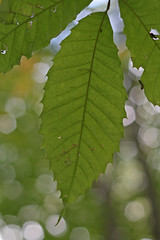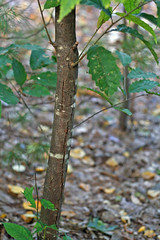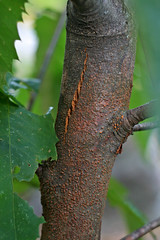 I realized a while ago that my knowledge of nature was woefully inadequate. Maple tree? Oak tree? Pine tree? There’s a difference? So I’ve been working on looking up various things, and when I can’t find an answer, posting photos of plants on Flickr to be identified.
I realized a while ago that my knowledge of nature was woefully inadequate. Maple tree? Oak tree? Pine tree? There’s a difference? So I’ve been working on looking up various things, and when I can’t find an answer, posting photos of plants on Flickr to be identified.
The leaves pictured at left seem to be those of the American Chestnut. It turns out that the American Chestnut is fairly rare. It’s apparently common for them to grow to about ten feet, until the trunk is an inch or two in diameter. And then…
Chestnut Blight strikes. (See photo on right.) It seems that the fungus was accidentally introduced to America in 1904 on Asian Chestnut trees, which were mostly resistant to the blight. American Chestnuts were not, and are not. They were pretty much totally wiped out. The trees aren’t affected until they’re somewhat large, but pretty routinely die before they’re able to drop seeds. As I understand it, there are viruses that attack the blight’s fungus, which can slow the blight enough for the tree to recover. The virus is chyphonectria parasitica. As I understand it, it is also common to inject trees with weakened strains of the blight, allowing them to recover. (Somewhat like a flu shot?)
 Over time the blight will cause multiple ‘cankers’ in the tree, and create reddish-orange spores. And inevitably, the American Chestnut dies. New growth from the base is common, sometimes growing five to ten feet tall, but almost never mature enough to reproduce.
Over time the blight will cause multiple ‘cankers’ in the tree, and create reddish-orange spores. And inevitably, the American Chestnut dies. New growth from the base is common, sometimes growing five to ten feet tall, but almost never mature enough to reproduce.
So I’ve become somewhat obsessive about this, trying to figure out what can be done to stop the blight to allow these trees to grow. Given that it’s a problem confounding lots of arborists, I have a hunch that the first idea that popped into my mind (spraying bleach on the blighted areas) may be less than ideal.
But I thought I’d share today’s trivial pursuit and useless knowledge with you.

Chestnut trees were much more common when I was a kid. We found the nuts all sorts of places. Chestnut is a great wood for a lot of things. If it were still common we’d be using it for decks and other places where we want wood that stands up to water.
The other tree in a similar situation is the elm. This is sad because like the chestnut tree the elm is a really great shade tree. There is work going on to bread trees that are resistant to the Duch Elm sickness that is killing them. There are some around though. In fact there is one really cool elm lined main street left in America. It’s in East Hampton NY and I spent the last few days there.
Matt:
Clarification: the blight fungus is called Cryphonectria parasitica.
There is a good article covering a range of strategies to protect against blight by Dr. Sandy Anagnostakis at CAES, this includes a good discussion on hypovirulence.
http://ct.gov/CAES/cwp/view.asp?a=2815&q=376826&pp=12&n=1
There is a huge diversity of vegetative compatibility in native populations of blight in Europe, China, Japan and North America. Furthermore, testing indicates that there isn’t a large amount of overlap in vc types from one location to the next. It is my understanding, that this is one of the reasons that hv alone has not been successful in protecting trees in a natural situation.
The good news, it that there are many other approaches including several aimed at creating a resistant tree. SUNY ESF and Univ. Georgia have been working on creating a transgenic tree. The American Chestnut Foundation has been working on breeding a blight resistant tree. Both approaches have shown amazing promise.